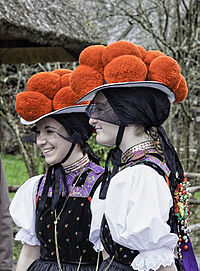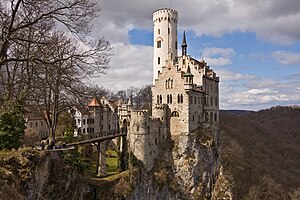Wikipedia:WikiProject Germany/Portal:Baden-Württemberg
Introduction

Baden-Württemberg (/ˌbɑːdən ˈvɜːrtəmbɜːrɡ/ BAH-dən VURT-əm-burg, German: [ˌbaːdn̩ ˈvʏʁtəmbɛʁk] ), commonly shortened to BW or BaWü, is a German state (Land) in Southwest Germany, east of the Rhine, which forms the southern part of Germany's western border with France. With more than 11.07 million inhabitants across a total area of nearly 35,752 km2 (13,804 sq mi), it is the third-largest German state by both area (behind Bavaria and Lower Saxony) and population (behind North Rhine-Westphalia and Bavaria). As a federated state, Baden-Württemberg is a partly-sovereign parliamentary republic. The largest city in Baden-Württemberg is the state capital of Stuttgart, followed by Mannheim and Karlsruhe. Other major cities are Freiburg im Breisgau, Heidelberg, Heilbronn, Pforzheim, Reutlingen, Tübingen, and Ulm.
What is now Baden-Württemberg was formerly the historical territories of Baden, Prussian Hohenzollern, and Württemberg. Baden-Württemberg became a state of West Germany in April 1952 through the merger of South Baden, Württemberg-Baden, and Württemberg-Hohenzollern. These three states had been artificially created by the Allies after World War II out of the existing traditional states by their separation over different occupation zones.
Baden-Württemberg is especially known for its strong economy with various industries like car manufacturing, electrical engineering, mechanical engineering, the service sector, and more. It has the third-highest gross regional product (GRP) in Germany. Part of the Four Motors for Europe and located in the Blue Banana, some of the largest German companies are headquartered in Baden-Württemberg, including Mercedes-Benz Group, Schwarz Group, Porsche, Bosch and SAP.
The sobriquet Ländle, a diminutive of the word Land in the local Swabian, Alemannic and Franconian dialects, is sometimes used as a synonym for Baden-Württemberg. (Full article...)
Selected article

A Bollenhut is a formal headdress worn since c.1750 by Protestant women as part of their local costume or Tracht in the three neighbouring Black Forest villages of Gutach, Kirnbach and Hornberg-Reichenbach. With its woollen pompoms, the picturesque-looking red Bollenhut has become a symbol of the Black Forest as a whole, despite its very local origins. The red pom-poms and white brim of the Bollenhut also is said to have inspired the top layer of the Black Forest Cake.
The broad-brimmed, whitewashed straw hat bears 14 prominent, woollen, pompoms arranged in the shape of a cross. Only eleven pompoms are visible, however, because three are covered by those on top. Spinsters wear red pompoms, married women wear black. The Bollenhut can weigh up to 2 kilogrammes and is manufactured by female milliners. The red Bollenhut may first be worn by girls at their confirmation.
Today the Bollenhut and associated Tracht are still worn on holidays and for traditional events. The Bollenhut and local costumes may be seen all year round e.g. in the Black Forest Costume Museum in Haslach im Kinzigtal.
Selected biography

Karl Friedrich Benz (German: [bɛnts] ; November 25, 1844 – April 4, 1929) was a German engine designer and engineer, generally regarded as the inventor of the first automobile powered by an internal combustion engine, and together with Bertha Benz, pioneering founder of the automobile manufacturer Mercedes-Benz. Other German contemporaries, Gottlieb Daimler and Wilhelm Maybach working as partners, also worked on similar types of inventions, without knowledge of the work of the other, but Benz received a patent for his work first, and, subsequently patented all the processes that made the internal combustion engine feasible for use in an automobile. In 1879, his first engine patent was granted to him, and in 1886, Benz was granted a patent for his first automobile.
State facts
- Nickname: Ländle
- Capital: Stuttgart
- Minister-president: Winfried Kretschmann
- Governing parties: Greens / CDU
- Total area: 35,751 km2 (13,804 sq mi)
- Population: 10,879,618 (2015)
- Founded: April 25, 1952
- Website: www.baden-wuerttemberg.de
Selected image
Did you know?

- ...that Oberried is home to the Barbarastollen caves, the central safekeeping archive of Germany. The Barbarastollen holds microfilms with millions of images from German archives and museums. The entire complex is buried under 400 meters of rock. It is intended to survive a nuclear war.
- ...that the civic symbol of Mannheim is der Wasserturm, a Romanesque water tower completed in 1886 that rises to 60 metres above the highest point of the art nouveau area Friedrichsplatz.
Subcategories
Selected panorama
 |
Heidelberg is a college town in Baden-Württemberg situated on the river Neckar in south-west Germany. At the 2015 census, its population was 156,257, with roughly a quarter of its population being students. A former residence of the Electorate of the Palatinate, Heidelberg is a popular tourist destination due to its romantic cityscape, including Heidelberg Castle, the Philosophers' Walk, and the baroque style Old Town.
Topics
Related portals
Associated Wikimedia
The following Wikimedia Foundation sister projects provide more on this subject:
-
Commons
Free media repository -
Wikibooks
Free textbooks and manuals -
Wikidata
Free knowledge base -
Wikinews
Free-content news -
Wikiquote
Collection of quotations -
Wikisource
Free-content library -
Wikiversity
Free learning tools -
Wikivoyage
Free travel guide -
Wiktionary
Dictionary and thesaurus
















